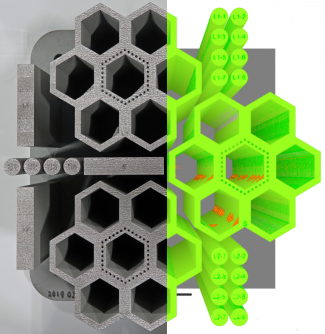Oak Ridge National Laboratory is behind the development of a new type of artificial intelligence (AI) software called Peregrine, meant to improve the quality of functional parts being produced via powder bed 3D printers. Peregrine requires no “expensive characterization equipment,” yet possesses the ability to evaluate parts during manufacturing. Throughout the production process, information is collected and assessed, and the following details are analyzed:
- Design
- Selection of materials
- Print builds
- Material testing
“Capturing that information creates a digital ‘clone’ for each part, providing a trove of data from the raw material to the operational component,” said Vincent Paquit, leader of advanced manufacturing data analytics research as part of ORNL’s Imaging, Signals and Machine Learning group. “We then use that data to qualify the part and to inform future builds across multiple part geometries and with multiple materials, achieving new levels of automation and manufacturing quality assurance.”

Oak Ridge National Laboratory researcher Chase Joslin uses Peregrine software to monitor and analyze a component being 3D printed at the Manufacturing Demonstration Facility at ORNL (Image: Luke Scime, ORNL, U.S. Dept. of Energy)
The software is based on a convolutional neural network that imitates the human brain, rapidly evaluating images from cameras during printing. A built-in algorithm then analyzes the data, evaluating pixels, and the quality of the structures and their overall shapes. If there is an error, powder bed printer operators are notified.
ORNL has been involved in a wide range of impressive projects featuring AM processes—from the development of new organic composites to bio-based materials, to the production of medical isotopes, and other quality control systems. In this project, they are focusing on contributing to the “factory of the future,” with users creating innovative, customized parts via CAD and then relying on 3D printing software to detect and correct errors.

Peregrine detects an anomaly in a component being additively manufactured on a powder bed printer. (Image: Luke Scime, ORNL, U.S. Dept. of Energy)
Such monitoring and correction offers a substantial, extended benefit in using 3D printing—as parts can be fixed before they come off the production line, saving time, money, materials, and preventing serious issues regarding performance.
With Peregrine, the goal is for industrial users to feel secure in knowing that the parts they are including in critical applications have been monitored, tested, and are ready for installation. The project was sponsored by DOE’s Office of Energy Efficiency and Renewable Energy’s Advanced Manufacturing Office and the DOE Office of Nuclear Energy, funding the TCR program. The software was created by researchers working in the Manufacturing Demonstration Facility at ORNL, known for their experience in developing and testing countless types of new technology.
“One of the fundamental challenges for additive manufacturing is that you’re caring about things that occur on length-scales of tens of microns and happening in microseconds, and caring about that for days or even weeks of build time,” said ORNL’s Luke Scime, principal investigator for Peregrine. “Because a flaw can form at any one of those points at any one of those times, it becomes a challenge to understand the process and to qualify a part.”
The research is fully detailed by Luke Scime, Derek Siddel, Seth Baird, and Vincent Paquit in “Layer-wise anomaly detection and classification for powder bed additive manufacturing processes: A machine-agnostic algorithm for real-time pixel-wise semantic segmentation.” In explaining how the convolutional neural network functions, the researchers point out key benefits such as the capability for offering segmentation results of the sensor, as well as transferring data from one AM machine to another in real time.
[Source / Images: news wise]Subscribe to Our Email Newsletter
Stay up-to-date on all the latest news from the 3D printing industry and receive information and offers from third party vendors.
You May Also Like
Profiling a Construction 3D Printing Pioneer: US Army Corps of Engineers’ Megan Kreiger
The world of construction 3D printing is still so new that the true experts can probably be counted on two hands. Among them is Megan Kreiger, Portfolio Manager of Additive...
US Army Corps of Engineers Taps Lincoln Electric & Eaton for Largest 3D Printed US Civil Works Part
The Soo Locks sit on the US-Canadian border, enabling maritime travel between Lake Superior and Lake Huron, from which ships can reach the rest of the Great Lakes. Crafts carrying...
Construction 3D Printing CEO Reflects on Being Female in Construction
Natalie Wadley, CEO of ChangeMaker3D, could hear the words of her daughter sitting next to her resounding in her head. “Mum, MUM, you’ve won!” Wadley had just won the prestigious...
1Print to Commercialize 3D Printed Coastal Resilience Solutions
1Print, a company that specializes in deploying additive construction (AC) for infrastructure projects, has entered an agreement with the University of Miami (UM) to accelerate commercialization of the SEAHIVE shoreline...





























